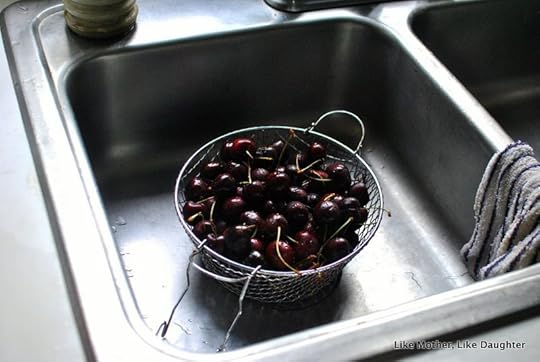Thoughts on getting the reluctant child to read, with 7 practical suggestions.
[image error]
Dear Auntie Leila,
I am reading through your library project posts and wholeheartedly agree with what you write, but am trying to pinpoint where I went wrong. I have saved hundreds of books from library book sales and thrift stores and garage sales. I have used various Catholic homeschooling book lists as my guide (and even tried homeschooling some of my kids at different points), yet my kids ignore or refuse most of them as boring (like Heidi), and constantly come home from the library and from school with cotton candy.
They are enrolled in Catholic school with Catholic teachers in our very solid diocese, yet I am often disappointed. I quietly donate most of the Scholastic books they pick from the treasure box or receive as gifts from their teachers. I refuse to read most of them aloud (once at the most) because they are “not very good” and suggest a different option (either something I checked out or something from our shelves…maybe shelves that need to be purged because I have too many books, maybe books that are not good?).
My 13 and 14yo girls are only interested in fantasy (the teen section is off limits), my 9 and 11yo boys don’t like reading, and my 6yo daughter is firmly entrenched in “character” — i.e. Disney books and Dora — books. Two more coming up in the ranks… both boys, an infant and 2 year old. Where am I losing them and how do I get them back?
Thanks for your thoughts,
Reading Mother
[image error]
Dear Reading Mother,
I think that even in good Catholic schools we really have a problem. People just don’t know what good literature is. Let’s face it — teachers are from the generation that was raised on Disney. They themselves simply don’t know a good book from a bad one, and they also don’t know anything about developmental stages in reading.*
It’s really hard to get people to understand that simply having “good doctrine” does not equal “building a civilization.” Yes, it’s a necessary prerequisite. But it’s not sufficient.
And it’s not enough to say — as we do, all the time! — “at least X is not bad.”
When it comes to what our children read, everything needs to be excellent. Yes, many children will need lots of books, because they read quickly and are hungry for more. But even the books they read for entertainment need to have a certain standard. And the fact is that before the publishing industry got monetized, there was a standard in even pulp fiction (although there has always been bad literature, no doubt about it — I’m speaking of what made its way into schools).
Now, the issue is that not only are the mores of the content corrupted, even the language is not good quality. Not to say that every book from the past is good. Not at all. A lot of it was silly and ignorant. But a certain process enabled the good to rise to the top and the bad to fall away. Now that process has been interfered with by marketing metrics. When books are dumped on schools because they are cheap to produce or have a proven track record of sales, parents must be vigilant.

Definitely refine your own collection. Get rid of all Disney, and everything that plays into some sort of marketing scheme — for instance, no Disney Winnie-the-Pooh, only E. H. Shepard. It goes without saying that Dora — just, no. Of course, I don’t know what you mean by “fantasy” — lots of variations of quality covered by that word! Tolkien, of course. The Golden Compass books, absolutely not.
Boys of the age of yours in general often don’t have time for reading, but that doesn’t mean they won’t when there’s nothing else to do. Work into your daily schedule some “down times” when they really have nothing else to do but read — and it can be only 40 minutes a day!
I will say that knowing one has to write a book report can deaden the will to live, never mind to read. Auntie Leila can barely think of it. Maybe just have sympathy for the victim and let him know that the best way to accomplish the task is to simply enjoy the book, the better to be able to recount it later.
Keeping a commonplace book really helps, by the way — not as a burden, but as a great record for the future. Everyone will be excited to get a new notebook in which to record the books read and a few thoughts about what made the book great or disappointing. If they can think of it as a “lifetime log” it might have a lot of appeal. Rosie’s Captain P. did this (when he was a kid — he wishes now he had kept it up!), and now he enjoys looking over his entries.
I make a distinction between one’s own list and those supposedly motivational “reading club” lists that libraries have. Good books sometimes take a while to read — it’s really not about quantity, is it? Nor is it a competition. Deep pleasures like reading must be carefully cultivated without reference to outside rewards. (I am put in mind of a reading challenge in our old town’s school one year long ago — the “prize” for the kid who read the most was, wait for it, a Sony Gameboy. Talk about misguided… )
Some other suggestions:
1. Like anything else, bad drives out good, and getting back up to where you need to be takes effort. Because newer books aimed at kids are easy to read and morally not demanding, they drive out the harder ones. The remedy is to read aloud very exciting, somewhat demanding books. If they are up for it, read them more than once. Look at my “read-aloud” category on the blog.
2. Entice/trick them. A great strategy for this is to read one chapter out loud — or two — to the targeted kid, just until the action starts. Then say, “Oh, I have to go close up the chickens.” Usually said kid will pick the book up to find out the rest — as long as he doesn’t have video games or shows to tempt him away, and if only to avoid having to deal with the chickens himself.
3. Leave good books in the bathroom. Just a few. Leave them right in reach…
4. Put a lamp that has a clamp on the frame of each child’s bed. When he goes to bed, let him read if he likes — just tell the children to turn off the light when they are ready for sleep, or perhaps you could ring a discreet little bell or something to signal the end of reading time. It’s fine to get 8-11 year-olds to bed a little early so they can read, carefully selecting their material beforehand.
Please make an effort to get an incandescent bulb for the lamp. I know it’s not easy, but the light needs to be appealing and soft. One thing I’ve noticed is that it’s hard for families to get good lighting somehow — often I’m not surprised that the children don’t read, because honestly, the only light comes from a harsh bulb in a center fixture in the ceiling; and now it’s harder than ever, since incandescent bulbs have been banished. You can find them here. The light for a bedside lamp does not need to be bright — you can even use the chandelier bulbs you find in the grocery store (the ones that fit a standard, not extra-small, socket). That way siblings aren’t kept awake. Trust me on this one. (At the barest minimum, get an LED lamp with the softest color possible… )
5. Sometimes you have to detoxify the mind — not by trying to eliminate the bad but by only offering the good. Even a week of being in the “deprivation tank” with only good books to read will really set them up. Rotate the books in a crate. Every week choose 10 or 15 that you think will appeal to the different ages. Put them in a prominent place. Rest time is a good time to bring this out, saying, We’re going to have a quiet hour, please choose something to read! Let them wander off with a book from the crate, and don’t worry about age level — it will all sort itself out.
Detoxifying often means that the middle-schooler who has been reading Judy Blume (how can it be that schools are still pushing Judy Blume?) can’t go straight to Johnny Tremain or Swallows and Amazons. He needs a re-set. He needs a stop at the “lower reading level” of Beverly Cleary or Tintin (the movie is cute too) or My Father’s Dragon or The Hardy Boys (get an old one). Good books are good, no matter what the age level. When C. S. Lewis took in children escaping the bombing of London during the War and began reading aloud to them, he discovered that Beatrix Potter is a genius!
The best of all is if you can go on vacation somewhere rather rustic where this crate is, other than the outdoors, the only source of entertainment!

6. Find them good friends who love to read. Pray about it, because sometimes it is difficult, I know. The problem with school, I just have to say, is that the peer group (which is indeed so necessary to the older child) is debased. Our children are vulnerable to the influence exuded by a group of children left without mentors, without teachers who are committed to creating a community of virtue and learning. Don’t underestimate the power of the peer group to drain all the joy out of reading… but the flip side of that coin is that good friends encourage the lagging to reach for new heights!
7. There has to be some sort of conceptual difference in their minds between the schlocky stuff “out there” and the excellent books you choose for them. You can start talking this up.
Your older girls especially need to start being discerning. You can begin a sort of benign “indoctrination” where you have conversations about books, read lists together, read articles (like this one by William Fahey, president of Thomas More College), maybe watch costume dramas of good books (there are excellent ones of Dickens books, like Our Mutual Friend, and I highly recommend North and South — the BBC version of Mrs. Gaskell’s classic, not the TV series featuring Patrick Swaze, which dear Erin, bless her, watched bemusedly for quite a while before she surmised that it was not the series I meant to recommend).
When, eventually, you read Chapter 10 of Little Women together and realize how much more fun life is when you can reference Pickwick and know what you are talking about, why, then you will be in business. Who knows, they may even start a literary club and magazine of their own!
Everyone will enjoy reading E. Nesbit after watching The Railway Children! When you win them over, you won’t have a lot of trouble with the boys. Younger children tend to live up to what the elder ones hold as a standard.
This summer, why not start reading Penrod out loud, or Anne of Green Gables, or Kidnapped? Definitely read Betsy-Tacy, Heidi (discussed in this post that gives you confidence to direct your child’s reading), Pippi, and Narnia to the six-year-old. Pop some corn, get your cookies and milk, build a bonfire, or otherwise entice the older kids to listen as well. Now is the time to get your older children to develop their taste in books!
See what you think!
Love and a big hug,
Leila
Do you have any good strategies to give children good reading habits? Please share them in the comments!
*I have many posts on reading, including this series on Teaching Children to Read, so do check them out! Especially, when the topic is the reluctant reader, do read the note at the bottom of this post, and the comments related to it.
The post Thoughts on getting the reluctant child to read, with 7 practical suggestions. appeared first on Like Mother Like Daughter.



